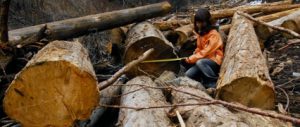Those puzzling over how to finance a means to reduce deforestation – which contributes the same amount of emissions as the entire global transport sector combined – received some encouragement at the UN-led climate meeting in Durban this week. An à la carte approach, where no source is ruled out, is emerging, leaving the door open to private-sector finance for the first time. And with progress imminent in two other crucial areas of safeguards and reference levels, REDD+, a novel mechanism to halt deforestation, is once more likely to be the biggest winner of the summit.
Such incremental political steps are vital to a process that, if implemented, experts estimate could provide a fifth of the world’s carbon-reduction potential by 2020. But frustration at the pace of the UN process is growing in Durban and many fear that, without a major kick start, REDD+ is at risk of failing before it has a chance to get going.
To save it, the world urgently needs to take measures to scale up forest finance, otherwise forest countries and communities, many of which are among the world’s poorest, cannot commit to permanent land-use policies that preserve forests. Establishing a large, reliable buyer for forest carbon is one way to achieve this, and also offers major co-benefits of simultaneously protecting biodiversity and reducing poverty.
Today, forest countries, communities and landowners can choose to harvest their forests sustainably for wood or fuel, or to clear them to earn income through other activities such as growing soft commodities like soy or palm oil. With demand for food and other commodities rising, clearance is becoming more attractive as forests appear to be worth more felled than standing.
REDD+, on the other hand, offers a chance to tap into the estimated US$2 trillion to US$4 trillion (12.7 trillion yuan to 25.5 trillion yuan) per year at which these forests’ ecosystem services are valued. However, to participate, forest countries and communities must commit to an alternative, long term, sustainable development path based on activities that do not lead to deforestation. To incentivise them to do so, the world needs to make similarly long term commitments to pay for the avoided carbon emissions.
To halve the rate of deforestation will take an estimated US$30 billion (191 billion yuan) annually – far too much for governments to raise on their own. Meanwhile, demand for forest carbon through the “voluntary carbon market” is so far limited to about a thousandth of this: between US$30 million and US$100 million (191 million yuan and 636 million yuan) per year.
Developed countries have pledged around US$4.5 billion (28.6 billion yuan) over the next three years towards REDD+, a large proportion of which is earmarked to build the legal and social architecture to make the mechanism work, in the hope that “if we build it, they (the forest countries and communities) will come”. The problem with this is that there is no agreed framework or committed finance to pay for forests in the long term.
The solution is to create reliable long-term payments for the carbon storage and other ecosystem services forests provide. Governments can source these in several ways, for example through aid, re-aligning perverse subsidies or auctioning of emissions allowances. The most immediately scalable would be to allow REDD+ carbon into the world’s largest compliance carbon market, the European Emissions Trading Scheme (ETS), which accepts carbon offsets from emerging markets if they arise from energy conservation or renewable energy projects, but excludes forest carbon. The ETS should set standards to accept forest carbon, or create incentives to create demand for it as soon as possible and ideally by 2013 when the next phase of the ETS begins.
A more tractable solution, however, could be to create a global, or European, Forest Finance Facility (FFF) with the authority to enter into long-term commitments to pay for performance (verified reductions in deforestation). At least US$3 billion (19 billion yuan) could be raised for the FFF from advanced pledges by developed countries to the proposed US$100 billion (636 billion yuan) Green Climate Fund being debated at the UN meeting in Durban, and by redirecting a portion of the $4.5 billion (28.6 billion yuan) of public money already pledged to REDD+.
Acting as an “advance market commitment” mechanism, the FFF could attract much larger scale private investment through innovative instruments such as forest bonds, potentially leveraging public funds significantly. Better than a carbon market, it could make long-term commitments to guarantee to purchase forest carbon credits at an agreed floor price, subject to REDD+ projects meeting objective criteria, including strong environmental and social safeguards. Profits from potential credit sales in a future compliance market could repay investors, renew the fund and reward forest communities.
With a funded alternative development path in sight, leaders in forest countries and communities might at last find it in their economic interests to stop unsustainable land-use practices and enforce regulations against violators. A long-run revenue stream might also allow forest countries and communities, many of which are in high-risk places, to purchase insurance against political or policy risk from organisations like the World Bank’s Multilateral Investment Guarantee Agency (MIGA). Together, this would unlock institutional investment into worthy REDD+ projects that would otherwise go unfunded.
While the world debates long term market mechanisms, a Forest Finance Facility would kick start real emissions reductions now, and produce faster returns on the billions of taxpayer dollars being spent on capacity building. Most importantly, it would allow REDD+ to unlock a new sustainable growth path for forest communities.
Donald P Kanak is the former chair of WWF’s Forest Climate Initiative and chairman of Prudential Corporation Asia.
Andrew W Mitchell is the founder and director of the Global Canopy Programme in Oxford.
Homepage image by Tim Cronin/CIFOR



